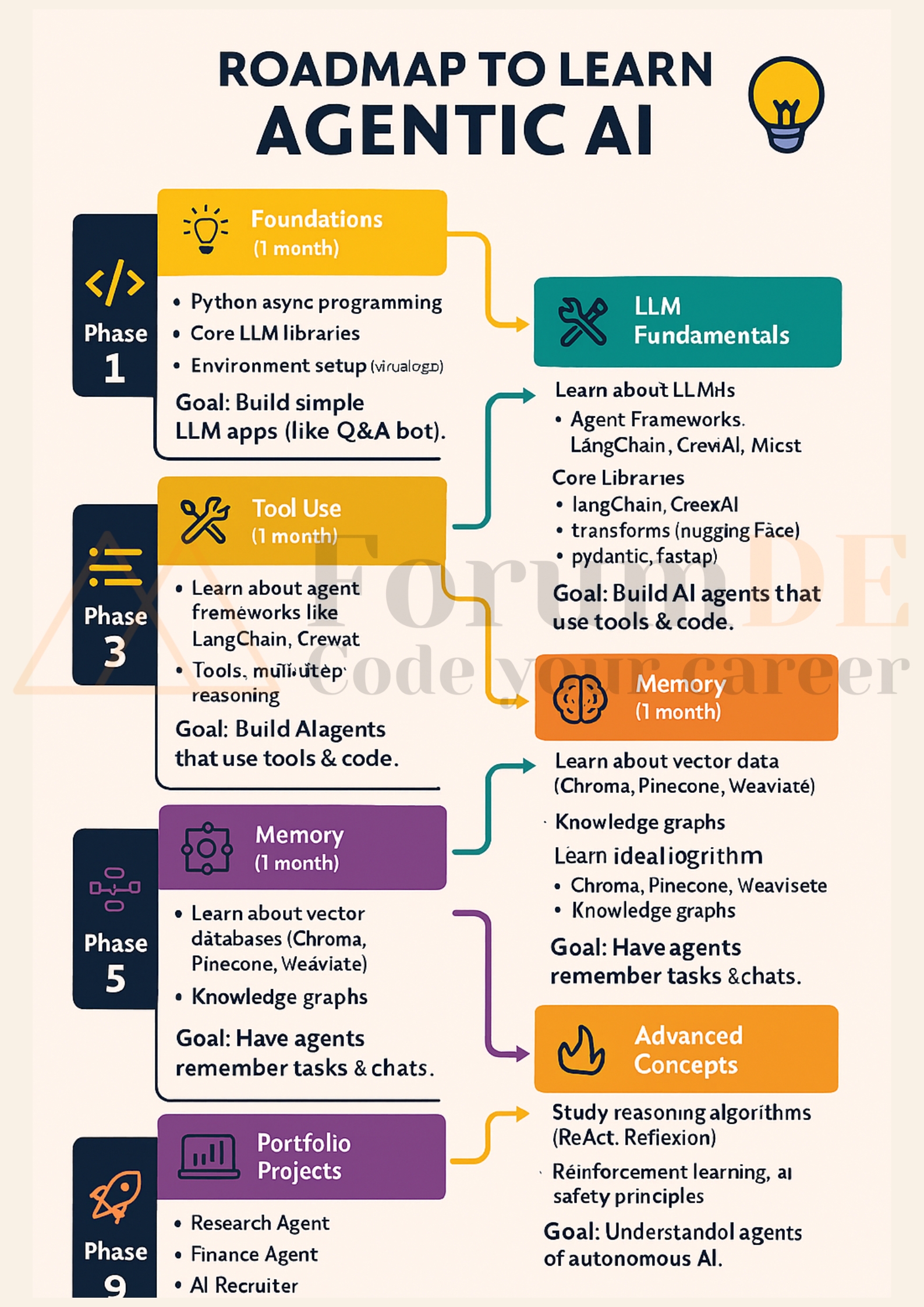What Is Agentic AI?
Agentic AI = LLMs (like GPT-4/5) + Autonomy + Tools + Memory + Planning.
In simple terms, it’s AI that can:

-
- -Think and reason (using LLMs)
-
- -Plan actions toward a goal
-
- -Use tools (APIs, databases, browsers, etc.)
-
- -Remember past interactions
-
- -Collaborate with other agents
Examples:
-
ChatGPT with tools & memory
-
AutoGPT, BabyAGI
-
Devin (AI software engineer)
-
AI customer support or trading agents
Agentic AI Learning Roadmap (2025)
Phase 1: Foundations (1 month)
Learn Python for AI:
-
Data structures, functions, OOP
-
Async programming (
asyncio) -
APIs (
requests,aiohttp) -
Environment setup (virtualenv, Poetry)
Core Libraries:
-
langchain -
openai/anthropic -
transformers(Hugging Face) -
pydantic,fastapi
Learn Prompt Engineering:
-
Basic prompting techniques
-
Chain-of-thought reasoning
-
Few-shot, zero-shot prompting
-
Function calling and structured outputs
Goal: Build simple LLM apps — e.g., “Document summarizer,” “Q&A bot.”
Phase 2: Large Language Model (LLM) Fundamentals (1–1.5 months)
Understand LLM Architecture:
-
Transformer architecture
-
Attention mechanism
-
Tokenization & embeddings
-
Fine-tuning vs. prompt-tuning
Frameworks to Learn:
-
Hugging Face Transformers
-
OpenAI API (GPT models)
-
Ollama / LM Studio for local models
-
LangChain / LlamaIndex for orchestration
Practice:
-
Build simple chatbots using OpenAI API
-
Use embeddings for semantic search
-
Use
LangChainfor RAG (Retrieval-Augmented Generation)
Goal: Understand how LLMs “think” and how to control their reasoning.
Phase 3: Tool Use and Reasoning (1 month)
Learn Agent Frameworks:
-
LangChain Agents
-
CrewAI
-
LlamaIndex Agents
-
AutoGen (Microsoft)
-
OpenDevin (for autonomous coding)
Key Concepts:
-
Tool definition (
toolsin LangChain) -
Multi-step reasoning
-
Planning and reflection
-
Memory (short-term, long-term)
-
Agent workflows
Practice Ideas:
-
Web-searching agent (using SerpAPI)
-
File-reader agent
-
Email summarizer agent
-
Multi-agent chat simulation
Goal: Build an AI agent that can use tools like Google, Notion, or Python code to complete tasks.
Phase 4: Multi-Agent Systems (1.5 months)
Learn Multi-Agent Architectures:
-
Coordinator vs. Specialist agents
-
Communication protocols (messages)
-
Role-based agents (planner, executor, critic)
-
Reflection loops (ReAct, Reflexion, etc.)
Frameworks:
-
AutoGen (Microsoft)
-
CrewAI (open-source)
-
LangGraph (graph-based agent workflows)
-
OpenDevin (AI software dev agent)
Build Projects:
-
-Multi-agent task solver
-
-AI content creation team (writer + editor + fact-checker agents)
-
-AI recruiter (job-matching agent system)
Goal: Build autonomous, communicating AI systems with memory and tools.
Phase 5: Memory, Knowledge, and Context (1 month)
Learn About:
-
Vector databases:
Chroma,Pinecone,Weaviate,FAISS -
Context window management
-
Episodic vs. semantic memory
-
Knowledge graphs
Tools:
-
LangChain Memory
-
LlamaIndex Memory
-
Postgres + pgvector
-
Milvus / ChromaDB
Goal: Make your agent remember — past chats, tasks, or learn from new data dynamically.
Phase 6: Real-World Integration (2 months)
Integration Skills:
-
RESTful APIs & webhooks
-
Databases (Postgres, MongoDB)
-
Frontend (React/Next.js or Streamlit)
-
Cloud (AWS Lambda, GCP Functions)
Tools to Learn:
-
FastAPI for backends
-
Streamlit / Gradio for AI dashboards
-
Docker + GitHub Actions for deployment
Example Projects:
-
-AI Research Assistant
-
-AI Email Manager
-
-Autonomous Business Analyst
-
-AI Developer Assistant (like Devin)
-
-AI Workflow Orchestrator for marketing/data tasks
Phase 7: Advanced Concepts (Ongoing / 2–3 months)
Study Advanced Topics:
-
Agentic reasoning (Reflexion, ReAct)
-
Planning algorithms (Tree of Thoughts, Graph of Thoughts)
-
Reinforcement Learning with Human Feedback (RLHF)
-
Fine-tuning LLMs for agent tasks
-
AI safety and alignment principles
Goal: Understand the science behind autonomous decision-making.
Phase 8: Projects & Portfolio
Build Real Projects:
-
Research Assistant Agent — reads PDFs, answers questions
-
AutoGPT Clone — multi-step goal completion
-
Financial Analyst Agent — pulls data, builds insights
-
Multi-Agent Chat System — debate or collaborate on a goal
-
Memory-Enabled Chatbot — remembers context from previous sessions
Phase 9: MLOps + AgentOps (Deployment Level)
-
Learn LLMOps / AgentOps concepts
-
Tracing, evaluation, and debugging agents
-
Logging & monitoring (LangSmith, Helicone)
-
Feedback loops
-
Cost optimization
-
-
Deploy agents to production
-
Dockerize
-
Deploy on AWS/GCP/Azure
-
Use LangServe / FastAPI endpoints
-
Suggested Timeline (8–10 Months)
Phase Focus Duration 1 Python & Prompting 1 month 2 LLM Foundations 1.5 months 3 Agents & Tool Use 1 month 4 Multi-Agent Systems 1.5 months 5 Memory & Knowledge 1 month 6 Integration & APIs 2 months 7 Advanced Topics 2–3 months 8 Projects + Deployment Ongoing
Tech Stack Summary
Area Tools / Frameworks Core LLMs OpenAI, Anthropic, Hugging Face Agent Frameworks LangChain, AutoGen, CrewAI, LlamaIndex, LangGraph Memory Chroma, Pinecone, Weaviate Backend FastAPI, Flask Frontend Streamlit, React, Gradio Databases Postgres, MongoDB Cloud & DevOps AWS, Docker, GitHub Actions Monitoring LangSmith, Helicone, AgentOps
Bonus: Learn from Real-World Projects
-
OpenDevin (GitHub)
-
AutoGPT / BabyAGI
-
Voyager
-
MetaGPT
-
CrewAI official examples
-
📚 Chapters
Roadmap To Learn Agentic AI
✍️ By Arun Kumar | 11/14/2025
Agentic AI is one of the most cutting-edge fields in AI , combining autonomous AI agents, LLMs, and tool-using reasoning systems.
Below is complete roadmap to learn Agentic AI from scratch — step-by-step, with clear concepts, tech stack, and projects.
💬 Comments
Comments (0)
No comments yet. Be the first to share your thoughts!